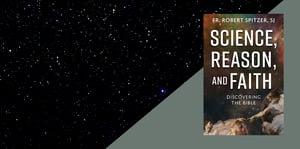“The purpose of this book is to answer the great questions of science, reason, and faith arising out of the Bible in its dialogue with modern science, history, and scriptural interpretation.” —Fr. Robert J. Spitzer, SJ
Science Reason and Faith: Discovering the Bible by Fr. Robert J. Spitzer, SJ, is the latest addition to the Spitzer canon covering the intersection of faith and science. It is written in an easy-to-digest Question and Answer format with two sections: the first concerning questions arising from the Old Testament, followed by those from the New Testament. It is an invaluable tool for catechists, teachers, and laypersons—enabling them to become competent witnesses to the truths of Revelation as they meet the great scientific questions of our modern times.
The major questions arising from the Old Testament include the existence of God and of the soul, the historical veracity of the Scriptures, including miracles, the veracity of the Creation account in Genesis, and its integration with the Big Bang, cosmology, and evolution. Those from the New Testament include the historicity of Jesus and all the events recorded in the New Testament, including Jesus’ miracles, Crucifixion, and Resurrection; scientific investigations of contemporary miracles; and the historicity of the founding of the Catholic Church with Peter as its head.
These are significant questions with multiple subtopics to explore within each one. Before starting, Fr. Spitzer discusses the relationship of the Church to the natural sciences, citing facts from history and quoting from the Catechism of the Catholic Church.
The Church Is Not Anti-Science and Our History Proves It
The Pontifical Academy of Sciences is supported by the Catholic Church, the only academy of its kind. Originally founded in 1603, re-established in 1847, and given its current name in 1936, it is the only supranational scientific academy. With ninety Nobel laureates throughout its history, it boasts 20 Nobel laureates within its current 80 members.
As if that is not impressive enough, the reader learns that the Catholic Church runs departments of natural science in over 1800 universities and 43,000 secondary schools. Fr. Spitzer also highlights the contributions of Catholic scientists to almost every scientific discipline. From the better-known contributions of the monk Gregor Mendel in the field of genetics and Fr. George Lemaitre’s Big Bang theory in cosmology to the lesser-known work of St.Nicolas Steno as the founder of modern geology. You will be reminded of the lesser-known contributions of the Jesuits to seismology, as well as those of Fr. Angelo Secchi, SJ, considered the founder of Astrophysics.
Questions Arising from the Old Testament
In the first section of the book, the reader will encounter perplexing questions that often get ignored or perhaps passed off with a shrug: ”Well, it's the Old Testament, after all.” In five dense chapters, Fr. Spitzer guides his readers through a short course on Biblical exegesis while examining specific questions. For example, how does one square the genocide of entire populations of conquered nations with a “good” God? Answers can be found in Chapter 5 in the section on the development of morality.
Does the Book of Jonah recount actual events (Three days in the belly of a whale? Really?) Or is it rather a “haggadic” (non-historical) story meant to convey a moral theme? Using distinctions found in OT Question #23, for example, the reader will be able to distinguish which miracles (“events that are scientifically and naturalistically inexplicable”) are historical or part of a different Biblical literary genre.
The previous chapters explore equally significant topics. These include the scientific findings that point to the existence of a transcendent God and soul, the relationship between science and the Bible, and the historicity of the Old Testament itself. Reading this section reveals a rich landscape of ideas and insights into the intellectual history behind belief in God and a transcendent soul and the exegesis of the Old Testament texts.
Questions Arising from the New Testament
The key questions arising from the New Testament are examined in four engrossing chapters of Part 2. The answers to these questions have deep roots in the history and doctrines of the Church. As in Part 1, Fr. Spitzer does not shy away from complex or contentious issues.
The first chapter of this section presents the historical evidence for the historical person of Jesus and the veracity of events in the Gospel narratives. From extratestamental testimonies of non-Christian sources to an exposition of the power of oral tradition—especially given that the formative period of that tradition occurred within the lifetimes of many eyewitnesses to the events—this chapter provides a firm foundation for belief in the historicity of each of the Gospels.
The following chapter examines the validity of Jesus’s miracles, revealing their unique character and purpose, not just of healing from physical ailments but exorcisms and examples of raising the dead. As for Jesus’s claim of divinity, Fr. Spitzer again makes critical distinctions. Jesus did not reveal His identity directly to the crowds or religious authorities, but He did indirectly do so in five ways. For example, He applied the Messianic and eschatologically significant title “Son of Man” to Himself, performed miracles and forgave sins by His own power, and revealed His power over satan by performing exorcisms. The power to perform these activities was seen as belonging to Yahweh alone. Importantly, Jesus did directly reveal His identity to the Apostles, as seen in specific Gospel passages.
The final two chapters cover the historical and scientific evidence surrounding the Passion, Death, and Resurrection of Jesus. In one section after the other, the reader gains insights into the Eucharist, the Real Presence, and the need for an organized Church. For example, Fr. Spitzer presents arguments supporting that Jesus intended to found a Church and placed Peter at its head.
An Invaluable Resource in Discovering the Bible
This is but a brief overview of the rich content found within the pages of this book. As in all of his books, Fr. Spitzer has accomplished a superhuman feat by condensing an enormous amount of information into comprehensible and memorable packets of information. Whether you are a catechist, teacher, parent, or layperson desiring a deeper understanding of these questions, you will want this book in your library.
 Purchase this comprehensive book from the Magis Store.
Purchase this comprehensive book from the Magis Store.
With cross-references to other questions within the text and comprehensive endnotes, it will prove an invaluable reference, shedding light on the richness of Scripture and its dialogue with Nature. Reading this book will enrich your understanding and appreciation for all that Science, Faith, and Reason can do to shed light on the beauty and many truths found in Scripture.

